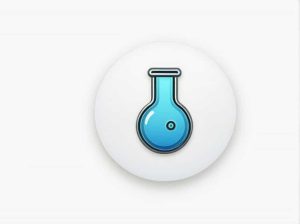Cupric sulphate also known as copper(II) sulfate is an inorganic compound widely used in agriculture chemistry and industry. It is commonly found as a blue crystalline solid (CuSO₄·5H₂O) or as an anhydrous white powder (CuSO₄).
Understanding the molecular weight of cupric sulphate is important for chemical calculations industrial applications and laboratory experiments. In this topic we will explore its molecular weight properties chemical structure and various applications.
Molecular Weight of Cupric Sulphate
The molecular formula of cupric sulphate is CuSO₄ (anhydrous form) and CuSO₄·5H₂O (pentahydrate form).
The molecular weight (molar mass) is calculated based on the atomic weights of its elements:
- Copper (Cu) = 63.55 g/mol
- Sulfur (S) = 32.07 g/mol
- Oxygen (O₄) = 4 × 16.00 g/mol = 64.00 g/mol
- Total (CuSO₄) = 159.62 g/mol
For the pentahydrate form (CuSO₄·5H₂O):
- Water (5H₂O) = 5 × (2 × 1.008 + 16.00) g/mol = 90.08 g/mol
- Total (CuSO₄·5H₂O) = 249.68 g/mol
Summary of Molecular Weights
| Form | Molecular Formula | Molecular Weight (g/mol) |
|---|---|---|
| Anhydrous Cupric Sulphate | CuSO₄ | 159.62 |
| Pentahydrate Cupric Sulphate | CuSO₄·5H₂O | 249.68 |
Chemical Structure of Cupric Sulphate
Cupric sulphate consists of copper(II) ions (Cu²⁺) and sulfate ions (SO₄²⁻).
- The anhydrous form (CuSO₄) is a white powder that readily absorbs moisture.
- The pentahydrate form (CuSO₄·5H₂O) has five water molecules bound to the copper ion forming a bright blue crystalline solid.
Hydrated vs. Anhydrous Cupric Sulphate
- Hydrated Cupric Sulphate (CuSO₄·5H₂O): Blue in color more stable and commonly used in industry.
- Anhydrous Cupric Sulphate (CuSO₄): White in color highly hygroscopic (absorbs water easily).
Physical and Chemical Properties of Cupric Sulphate
Physical Properties
| Property | CuSO₄ (Anhydrous) | CuSO₄·5H₂O (Pentahydrate) |
|---|---|---|
| Appearance | White powder | Blue crystalline solid |
| Molecular Weight | 159.62 g/mol | 249.68 g/mol |
| Solubility in Water | Soluble | Highly soluble |
| Density | 3.60 g/cm³ | 2.28 g/cm³ |
| Melting Point | 560°C (decomposes) | 150°C (loses water) |
Chemical Properties
-
Decomposition Upon Heating
- When CuSO₄·5H₂O is heated it loses water molecules and turns into CuSO₄ (anhydrous form).
- Reaction:
CuSO₄·5H₂O → CuSO₄ + 5H₂O
-
Reaction with Water
- Anhydrous CuSO₄ turns blue when exposed to water due to the formation of CuSO₄·5H₂O.
- This property is used as a test for water presence in chemical analysis.
-
Reaction with Ammonia
- Cupric sulphate reacts with ammonia to form a deep blue complex known as tetraamminecopper(II) sulfate.
- Reaction:
CuSO₄ + 4NH₃ → [Cu(NH₃)₄]SO₄
-
Reaction with Iron and Zinc
- CuSO₄ can react with iron (Fe) or zinc (Zn) to form copper metal (Cu) and corresponding sulfate salts.
- Example:
Fe + CuSO₄ → FeSO₄ + Cu
Synthesis of Cupric Sulphate
Laboratory Preparation
Cupric sulphate can be synthesized by reacting copper metal (Cu) with concentrated sulfuric acid (H₂SO₄) and an oxidizing agent (e.g. nitric acid HNO₃).
Reaction:
Cu + H₂SO₄ + HNO₃ → CuSO₄ + NO₂ + H₂O
Industrial Production
Industrially cupric sulphate is produced by leaching copper ores with sulfuric acid. It is then purified through crystallization.
Uses of Cupric Sulphate
1. Agriculture and Pest Control
- Used as a fungicide to protect crops from fungal infections.
- Added to animal feed as a copper supplement.
- Helps control algae growth in water reservoirs.
2. Electroplating and Metal Industry
- Used in electroplating processes to coat metals with copper.
- Helps in metal refining and ore processing.
3. Chemical Industry
- Used in chemical synthesis to produce other copper compounds.
- Acts as a catalyst in various chemical reactions.
4. Laboratory and Educational Uses
- Used as a reagent in chemistry labs for various experiments.
- Helps in analytical tests for water detection.
5. Textile and Dye Industry
- Used in dyeing and printing fabrics.
- Provides blue and green colors in textile processing.
Safety and Toxicity of Cupric Sulphate
Health Hazards
- Toxic if ingested and can cause nausea vomiting and stomach pain.
- Irritating to skin and eyes.
- Harmful if inhaled in powder form.
Environmental Hazards
- Toxic to aquatic life if released into water bodies.
- Must be handled and disposed of properly to prevent environmental pollution.
Precautionary Measures
- Always wear gloves and safety goggles when handling.
- Store in a dry place away from moisture.
- Dispose of in accordance with local regulations.
Cupric sulphate (CuSO₄) is an important industrial and laboratory compound with a wide range of applications. Understanding its molecular weight chemical properties and uses helps in various scientific and industrial processes.
The molecular weight of anhydrous cupric sulphate is 159.62 g/mol while the pentahydrate form (CuSO₄·5H₂O) has a molecular weight of 249.68 g/mol.
From agriculture and electroplating to chemical analysis and dyeing cupric sulphate plays a crucial role in different fields. However due to its toxicity it must be handled carefully and disposed of responsibly.



